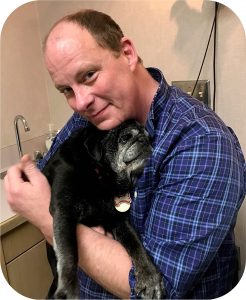Eye Problems in Senior Dogs
Dr. Sullivan gets up close and personal with ODH dogs Nicholas (left) and Duncan.
This week we’re pleased to have Dr. Tom Sullivan, a veterinary ophthalmologist at Animal Eye Clinic in Seattle talk about eye problems in senior dogs. Dr. Sullivan and his staff take very good care of Old Dog Haven dogs that are referred to him because of eye issues, and we feel very fortunate to have him and his team in Seattle. Dr. Sullivan loves seeing our dogs and says that Old Dog Haven “has a perfect mission and a beautiful concept.” We’d also like to thank Animal Eye Clinic for being a Platinum Paw Sponsor for the Walk for Old Dogs. We appreciate your support.
Why senior dogs are particularly vulnerable to eye problems
1-Some disorders are a result of aging and wear and tear. Cataracts, retinal degeneration, for example, are often age-related degenerative conditions.
2-Older animals have had more opportunity to sustain injury to the eyes, which can lead to long-term complications like glaucoma.
3- Some eye diseases are a result of systemic conditions—such as diabetes, high blood pressure, cancers—all of which are more common in the elderly.
The most common eye issues seen in senior dogs:
1- Calcific corneal degeneration: Some older dogs will start to mineralize the surface of the cornea in one or both eyes.
These deposits are gritty and uncomfortable in the beginning, then portions of calcified cornea can slough leading to deep ulcers. These are very slow to heal, in some cases they do not heal at all.
The areas of sloughing are thinner than normal, and in extreme cases the thin spot can rupture, leading to loss of fluid from inside the eye.
Calcific corneal degeneration can be seen with certain diseases (Cushing’s disease, kidney failure), but can happen as a consequence of aging alone.
It typically develops in dogs 14 or older. It looks like white spots on the surface of the cornea, and often it isn’t noticed until an ulcer develops and persists beyond normal healing time (at which point the patient makes their way to an ophthalmologist).
If caught early this can often be treated and maintained with drops to remove minerals from the corneal tissues.
2- High blood pressure: In addition to causing cognitive changes, high blood pressure can also cause ocular problems, particularly in dogs 10 or older. Dogs suffering from high blood pressure may develop one or more observable signs, including:
- Acute onset of blindness
- Ocular hemorrhage (bleeding inside of the eyeball, or globe)
- Dilated pupils
- Retinal detachment
- Abnormal eye movements (nystagmus)
How You Can Maintain Eye Health for your dog
Basically be aware that eye problems can worsen very rapidly in pets, so if a change is noted seek attention quickly.
Signs of a problem include increasing cloudiness, squinting, discharge (a new onset of tearing, mucous or especially yellow/green, infected-looking discharge), bulging or sinking in of the eye in the orbit, or a decrease in vision.
You want to feed a balanced diet and keep the hair around the eyes trimmed short enough to be able to keep it from irritating the eyes, as well as letting you see the eyes clearly enough to notice a problem early. (Groomers often are the first to notice an eye problem in longer-haired breeds.)
Some age-related conditions — senile retinal degeneration and age-related cataract development in particular — can result from oxidative stress, a fancy name for the wear and tear of everyday life, such as sunlight, UV exposure and time.
Antioxidant supplementation can help prevent this type of damage if your dog’s diet does not contain enough to do the job. Check with your vet about specific supplements and dosages.
These will not help with conditions that are a result of other types of damage, such as diabetic cataracts, inherited retinal diseases or glaucoma.
—————————–
About Dr. Sullivan:
Dr. Sullivan attended Cornell University College of Veterinary Medicine, where he developed a love of ophthalmology. Following graduation, he followed with a one year rotating internship as a clinician at Colorado State University College of Veterinary Medicine, then undertook specialty training in ophthalmology at North Carolina State College of Veterinary Medicine. N.C. State was a recognized world leader in veterinary ophthalmology- the training he received not only solidified his passion for ophthalmology, but also instilled a drive for innovation and lifelong learning within the field. He joined the Animal Eye Clinic in 1995, and has been the owner since 2000. Although he loves all things ophthalmic, special interests within the field include the surgical treatment of retinal detachment, management of uveitis in large and small animals, and treatment of zoo, aquarium, and wildlife species. When not working, he enjoys music, long walks, and spending time at home with his wife, their two teenage children, two dogs, two cats, one tortoise, and a collection of gregarious fish.



